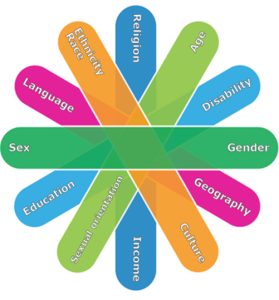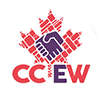Step 1 The Journey Begins:
Understanding the Historical Context
Key Concepts, Terms & Definitions
Your Inclusive Person-Centric Hiring Solution

Businesses and organizations will be at different stages on their journey to develop an inclusive hiring practice.
- Pause and take the time to understand our shared history and its implications on our society and workplace today.
- Take what you need as you need it – come back as often as you like.
- Broaden and refresh perspectives to guide you through the next five steps.
Note: This reflection will also spark insights into ways that you can strengthen efforts to build an inclusive environment for the long-term success of your new hire and existing team members in all their diversity.

Getting Started!
It is not expected that you will explore in depth all of the resources provided in this section at one time. We invite you to familiarize yourself with the topics and key terms presented that most resonate as you begin this work. When you progress through the remaining steps you will want to circle back to further investigate particular areas of interest or opportunities identified in your community outreach and strategy development.
Our History - Key Concepts Terms and Definitions
- It is important to note that the terms and acronyms used in this resource are provisional and are reflective of the understanding and relevance to promoting inclusion at the time of this solution design (2023).
- Respecting how terms come about, how they are tied to an individual or group’s identity, and how they are fluid and can be used differently by different persons in different contexts will assist you in your daily discourse and developing a more inclusive hiring strategy.
We hope you will find the historical context, detailed definitions and terms presented in the Historical Summary Resource helpful.
Three Steps to Understanding Racism in Canada
- In this spirit, we explore how key concepts, practices and terms take shape. Many terms used in the Canadian media or in legal and/or legislative policies and practices have evolved over time and for the most part have been an external creation placed upon persons and groups of people from outside their communities.
- Canada, as a colonial state, experiences the lingering impact of systems put in place to benefit white European colonists while disadvantaging the Indigenous populations. Prevailing superiority perspectives and discriminatory practices become so engrained and reinforced by a society’s institutions and systems that they go unnoticed. Racialized descendants and new racialized citizens over time face the extended ripple effects of what is today recognized as systemic racism.
- Individuals and organizations genuinely committed to confronting unconscious bias and systemic racism may feel discouraged and powerless. Fortunately, by being more mindful of the ways that systems work, promoting social accountability, and building inclusive anti-racist strategies in your hiring practices, you can make a real impact.
The following activity invites you to Explore 3 Steps to Understanding Racism in Canada.
Actions for Individuals Leaders and Organizations
Explore the many ways that Individuals – Leaders & Organization are promoting Inclusion, Diversity Equity & Access.
Using a Gender-based Analysis Plus (GBA+) Approach
We often assume that our workplace policies and practices impact or apply to everyone equally.
- In under 3 minutes, this video demonstrates how applying a Gender-based Analysis Plus approach to a hiring strategy can promote Inclusion, Equity, Diversity and Access in the workplace.

- Using a GBA Plus approach helps us recognize and move beyond our assumptions, uncover the realities of people’s lives, and find ways to eliminate barriers and provide equitable opportunities for all.
- Looking at issues and assumptions from a broad perspective and gathering facts to build understanding can help us avoid unintended impacts and develop options that honour diversity and promote inclusion within our organization and in our hiring practices.
Watch Video
This 4-minute video demonstrates how the City of Edmonton is using a Gender-Based Analysis Plus (GBA+) approach as a tool to understand how different genders and diverse people experience policies, programs and initiatives.
Take the GBA+ Self-Directed Online Course
- You will learn to define the key concepts of a Gender-Based-Analysis Plus approach
- Understand how taking a diversity-sensitive approach beyond gender and sex will help to broaden your recruitment appeal
- Recognize how various intersecting identity factors can influence the hiring experience and/or level of engagement of women, men, and gender-diverse people or equity-deserving groups
This self-directed course can be completed all at once or in short segments of time. (Viewing videos and additional resources can take approximately 2.5 hours to complete.)
We suggest you take notes and attend to the quizzes at the end of each section.
If you wish to receive a certificate of completion, there is a test at the end of the program. It requires a score of 80% or better. You can take the test more than once.
![]()
Complete this Activity
Exploring Advantages and Disadvantages
- It will be helpful to gain insight into how the intersecting aspects of our unique identities shape our lived experiences and afford each of us varying degrees of advantage or disadvantage based on society-imposed roles, rules, values and norms.
This reflective exercise is also featured in the final What’s Next sixth step of the resource. Both this activity and the GBA+ Professional Development Certificate will help your team cultivate a culture of belonging and create an environment where employees in all their diversity can thrive.
Step 1: Completed
In completing this step, you have explored how past and present biases evolve and how systems absorb and perpetuate them over time. You have also been introduced to the benefits of adopting a GBA+ approach in developing your Inclusive Person-Centric Hiring Strategy. By acknowledging the injustices of the past we can honour the best of our Nation and work together towards creating a more equitable society and better future for all.
Take What You Need - When you Need it - Come Back Often!
Resources/Links:
See the detailed list of all resources and citations used in the development of this step on the Resource Citations Page.




